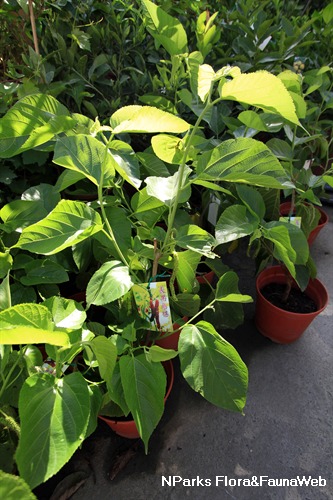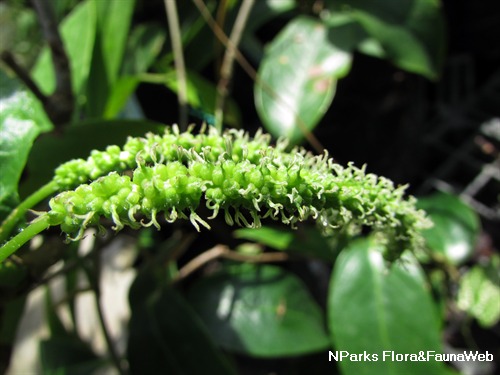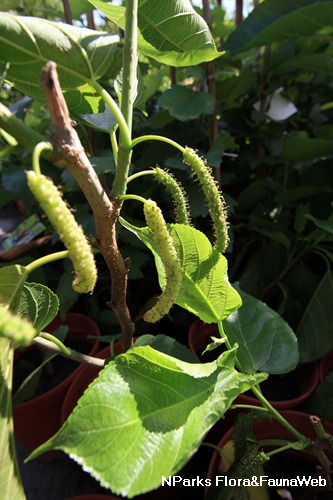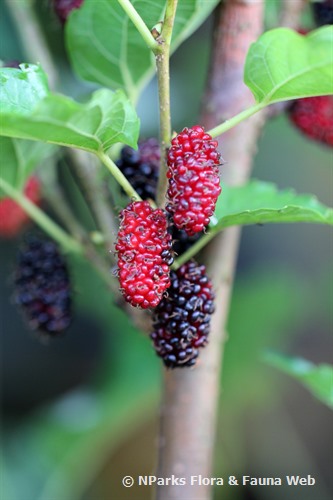
Back
Morus macroura Miq.
| Family Name: | Moraceae |
| Synonyms: | Morus laevigata Wall. ex Bureau |
| Common Name: | Dwarf Red Shartoot, Himalayan Mulbery, Long Mulbery, Pakistan Mulberry, 长果桑, 奶桑 |
Name
Classifications and Characteristics
| Plant Division | Angiosperms (Flowering Seed Plants) |
|---|---|
| Plant Growth Form | Tree, Shrub |
| Lifespan (in Singapore) | Perennial |
Biogeography
| Native Distribution | India, Bhutan, South China, Myanmar, Cambodia, Thailand, Sumatra and Java. |
|---|---|
| Native Habitat | Terrestrial |
Description and Ethnobotany
| Growth Form | It is a tree, up to 32 m tall. |
|---|---|
| Foliage | Leaves are distichously arranged, ovate shaped (5-15 cm wide and 5-9 cm wide), with dark green upper surface and pale green underneath. Leaf base is rounded to cordate with acuminate apex and toothed margin. Hairs are present on the veins. Petiole is 2 – 4 cm long and stipule is 1 - 1.5 cm long, hairy and may falls off early. |
| Flowers | Male inflorescence is in the form of catkins (4 – 8 cm long), axillary and paired. Male flowers comprises of filament (2.5 mm long) and round anthers (0.8 mm long). Female inflorescence is cylindrical (6 - 12 cm long), comprises of ovoid ovary (1 mm along) and 2-branched stigma (1.5 – 2 mm long). |
| Fruit | Fruit occurs as an aggregate fruit, which is also known as syncarp. It is yellowish white when mature and about 6 - 12 cm long. |
| Habitat | Montane and submontane forest, with altitude between 400m to 2500m. |
| Cultivation | It is propagated by seeds. Exposing seeds to 2 weeks to 3 months of cold stratification can help germination. |
| Ethnobotanical Uses | Edible Plant Parts : Edible Fruits Food (Fruit or Vegetable) Others: Fruits are eaten fresh or can be used just like any berry. This species is used for firewood. |
Landscaping Features
| Landscape Uses | Parks & Gardens |
|---|
Plant Care and Propagation
| Light Preference | Full Sun |
|---|---|
| Water Preference | Moderate Water |
| Plant Growth Rate | Moderate |
| Rootzone Tolerance | Well-Drained Soils |
| Propagation Method | Stem Cutting |
Foliar
| Mature Foliage Colour(s) | Green |
|---|---|
| Mature Foliage Texture(s) | Thin |
Floral (Angiosperm)
| Flower Grouping | Cluster / Inflorescence |
|---|---|
| Flower Location | Axillary |
Fruit, Seed and Spore
| Fruit Classification | Aggregate Fruit (Syncarp) |
|---|---|
| Plant Sexuality (non-Angiosperm) | Dioecious |
Image Repository
Others
| Master ID | 32692 |
|---|---|
| Species ID | 7104 |
| Flora Disclaimer | The information in this website has been compiled from reliable sources, such as reference works on medicinal plants. It is not a substitute for medical advice or treatment and NParks does not purport to provide any medical advice. Readers should always consult his/her physician before using or consuming a plant for medicinal purposes. |



